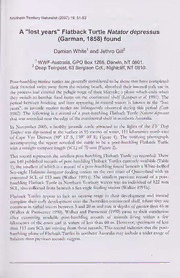Table Of ContentNorthern Territory Naturalist (2007) 19; 51-53
A "lost years" Flatback Turtle Natator depressus
(Carman, 1858) found
Damian White^ and Jethro Gill^
^ WWF-Australia, GPO Box 1268, Darwin, NT 0801.
^ Deep Tempest, 63 Sergison Get., Nightcliff, NT 0810.
Post-hatchling marine turtles are generally considered to be those that have completed
their frenzied swim away from the nesting beach, absorbed their internal yolk sac in
the process and entered the pelagic stage of their lifecycle; a phase which ends when
they switch to benthic food items on the continental shelf (Limpus et al. 1991). The
period bem^een hatching and later appearing in coastal waters is known as the “lost
years”, as juv'enilc marine turtles are infrequendy obsen^ed during this period (Carr
1982). The following is a record of a post-hatchling Flatback Turde Natator depressus
that was recorded near the edge of the continental shelf in northern Australia.
In November 2005, a healthy juvenile turtle attracted to the lights of the FV Deep
Tempest was dip-netted at the surface in 95 metres of water, 111 kilometres north-east
of Cape Van Diemen (10° 12' S, 130° 40' E; Figure 1). The verifying photograph
accompanying the report revealed the turde to be a post-hatchkng Flatback Turde
with a straight carapace length (SCL) of 70 mm (Figure 2).
This record represents the smallest post-hatchling Flatback Turde yet recorded. There
are 140 published records of post-hatchling Flatback Turtles currently available (Table
1), the smallest of which is a record of a post-hatchling found beneath a White-bellied
Sea-eagle Haliaeetus leucogaster feeding station on the east coast of Queensland with an
estimated SCL of 113 mm (Walker 1991a). The smallest previous record of a post¬
hatchling Flatback Turtle in Northern Territory waters was an individual of 122 mm
SCL, also collected from beneath a Sea-eagle feeding station (Walker 1991b).
Flatback Turdes appear to lack an oceanic stage in their development and instead
complete their early development over the Australian continental shelf, where they are
common in turbid waters between 5 and 20 m and rare at depths of greater than 45 m
(Walker & Parmenter 1990). Walker and Parmenter (1990) came to their conclusion
after examining available post-hatchling records of animals living within a few
kilometres of the coast and in waters of less than 60 m. However, specimens of less
than 113 mm SCL are missing from these records. This record indicates that the post¬
hatchling phase of Flatback Turdes in northern Australia may include a wider range of
habitats than previous records suggest.
52 Northern Territory Naturalist (2007) 19 White & Gill
Figure 1. Location of post-hatchling Flatback Turtle when dip-netted.
Figure 2. Post-hatchling Flatback Tuttle shordy before being released.
Flatback Turtle found Northern Territory Naturalist (2007) 19 53
Table 1. Post-hatchling Flatback Turtle records from Australian waters, collection
tj'pe, number of individuals and source of records.
State Collection type N Range (mm) Reference
WA Terrestrial 2 160 CCL* Chevron
Australia 2005
WA Beach-washed 5 121-145 SCLt Prince 1996
NT Beach-washed in derelict fishing nets 6 198-290 SCLt Roeger etal.
2004
WA, Sea eagie feeding stations, gilinets, 127 113-320 SCLt Limpus etal.
NT, trawl bycatch, tiger shark stomach 1991
QLD contents, beach-washed or observed
in estuary or coastal waters
‘Curved carapace length tStraight carapace length
Acknowledgements
The authors would like to thank Dr Scott Whiting for comments during draft
preparation and the loan of reference materials, and Karen Cook for providing the
map featured in this note.
References
Carr A.F. (1982) Notes on the behavioural ecolog>’ of sea turtles. In hiolog) and Conservation of Sea
Turtles (ed. K.A. Bjorn), p.l9. Smithsonian Institution Press, Washington.
Chevron Australia. (2005) Draft Environmental Impact Statement/Environmental Review
Management Program for the Proposed Gorgon Development: Technical Appendix C7,
Sea Turtles. ChervronTcxico Australia, Perth.
Limpus C.J., Walker TA. and West J. (1991) Post hatchling specimens and records from the
Australian region. In Proceedings of the Workshop on Marine Turtle Consen>ation, September 1990
(ed. R. James), pp. 95-100. Australian National Parks and Wildlife Service and Australian
Nature Conserv'ation Agency.
Prince R.I.T. (1996) First records of stranded juvenile flatback turtles, and some new records of
stranded juvenile hawksbill turtles from the southwest coast of Western Australia. Marine
Turtle Neu'sletterll, 5.
Roeger S., Munuqgurr M. and Wise P. (2004) Entanglement of Miyapunu (Marine Turtles) in Ghost
Netting: Northeast Arnhem laind, Northern Territory, Australia. Dhimurru Land Management
Aboriginal Corporation, Nhulunbuy NT.
Walker T.A. (1991a) Juvenile Flatback turtles in proximity to coastal nesting islands in the Great
Barrier Reef Province. Journal of Herpetology 25 (2), 246-248.
Walker T.A. (1991b) Post-hatchling turtles off Northern Australia. Marine Turtle Newsletter 55, 6.
Walker T.A. and Parmenter C.J. ^990) Absence of a pelagic phase in the life cycle of the
flatback turde, Natator depressa Journal of Biogeograplry 17, 275-278.

